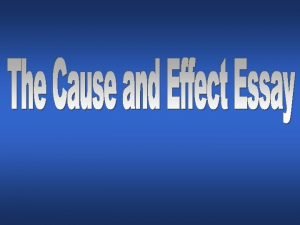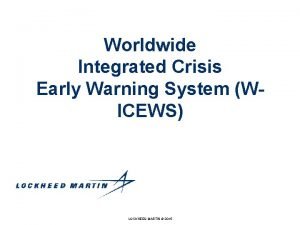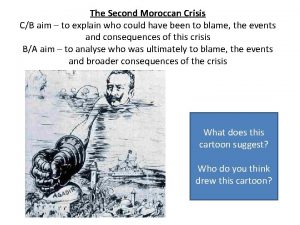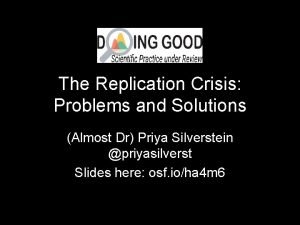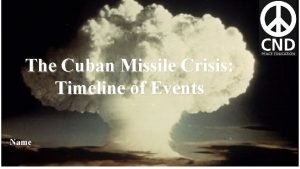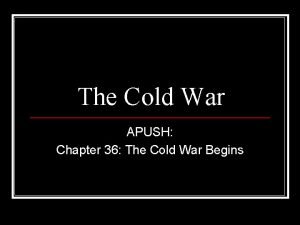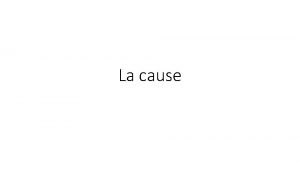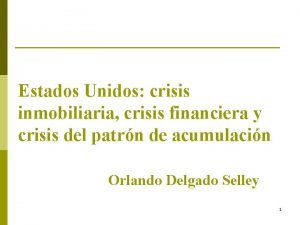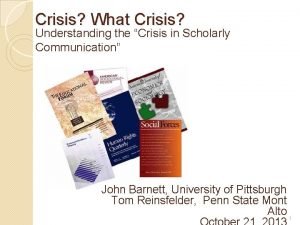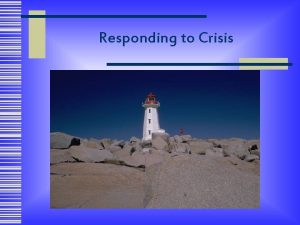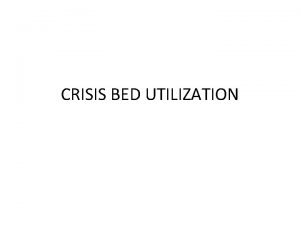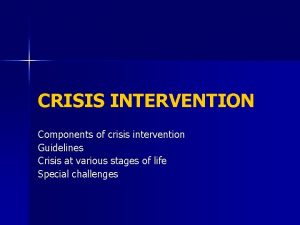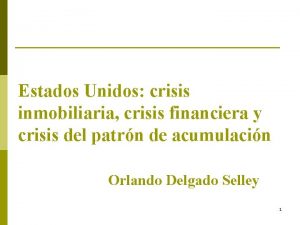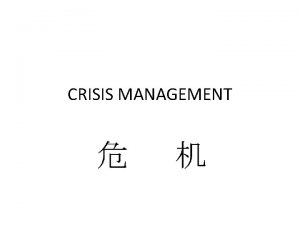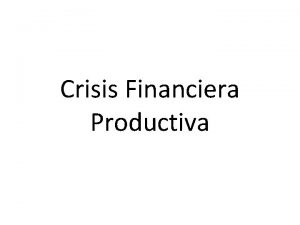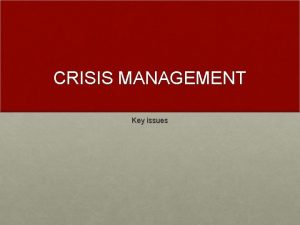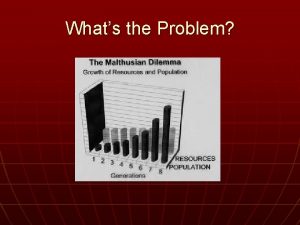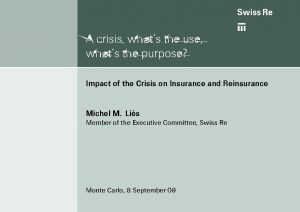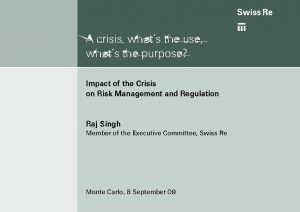Intermittency Crisis Whats intermittency Cause of intermittency Quantitaive





















- Slides: 21

Intermittency & Crisis • • • What’s intermittency? Cause of intermittency. Quantitaive theory of intermittency. Types of intermittency & experiments. Crises Conclusions

What’s Intermittency ? Intermittency: sporadic switching between 2 qualitatively different behaviors while all control parmeters are kept constant. periodic chaotic periodic quasi-periodic (Apparently) Y. Pomeau, P. Manneville, Comm. Math. Phys 74, 189 (80) Reprinted: P. Cvitanovic, “Universality in Chaos” fully periodic Intermittency fully chaotic ______ Ac ____________ A∞ ______ logistic map A = 3. 74, period 5 A = 3. 7375, Intermittency

Lorenz Eq. r = 165, periodic r = 167, intermittent

Cause of Intermittency: Tangent Bifurcation f(5) Saddle-node bifurcation A = 3. 74 period 5 5 stable, 7 unstable f. p. A = 3. 7375 intermittent 2 unstable f. p. ~ 4 cycles of period 5 Iterates of f(5)(0. 5)

Re-injection (Global features) n = 10 n = 21 Ref: Schuster n = 91: 96

(Reverse) Tangent Bifurcation Condition for birth of tangent bifurcation at period-n window: where For A > AC, at AC for the unstable f. p. → Type I intermittency for A < AC C. f. , for period-doubling, bifurcation is at Sine-circle map, K < 1: intermittency is similar but between freq-lock & quasi-periodicity

1/f noise Power spectra 1/fδ 0. 8 < δ < 1. 4 Power spectra of systems with intermittency also exhibit 1/fδ dependence. Too sensitive to external noise. See Schuster

Quantitative Theory of Intermittency Tangent bifurcation near stable n-period fixed point x* ( periodic for A > AC, intermittent / chaotic for A < AC ): Set: →

< 0 : periodic = 0 : tangent bif > 0 : intermittent

Average Duration of Bursts: Renormalization Arguments L = average length of bursts of periodicity L → 0 L → ∞ for >> 1 as → 0+ < 0 : periodic = 0 : tangent bif > 0 : intermittent L n( ) = number of iterations required to pass thru gap Analogous number for h(2) is Scaling: → h(2) → h → δ = 4

h(2) → h h(2 m) → h → 4 m Ansatz: → 4 Experimental confirmation: diode circuit Renormalization theory version: with there exists g such that

Ansatz → See Schuster, p. 45 Extension to other univ classes: B. Hu, J. Rudnick, PRL 48, 1645 (82)

Types of Intermittency Type III Tangent Hopf Period- doubling xn+1 = ε+ xn + u xn 2 rn+1 = (1+ε) rn + u rn 3 xn+1 = -(1+ε) xn - u xn 3 Θn+1 = Θn + Ω ε< 0 → ε > 0 M xn On-off intermittency = Type III with new freq ~ 0

Crises Unstable fixed point / limit cycle collides with chaotic attractor → sudden changes in latter • Boundary crisis: chaotic attractor disappears • Interior crisis: chaotic attractor expands Sudden changes in fractal structure of basin boundary of chaotic attractor: metamorphosis

Boundary Crisis Logistic map: • A*3 < A < 4: chaotic attractor expands as A increases. • A = 4: chaotic attractor fills [0, 1] and collides with unstable fixed point at x = 0. • A > 4: chaotic attractor disappears; new attractive fixed point at x = -∞. • A 4: escape region = [ x-, x+ ], i. e. , f(x) > 1 if x [ x-, x+ ] → Average duration of chaotic transient Universal for quadratic maps. for A 4

2 -D Henon map: crisis near C = 1. 08

Interior Crisis Logistic map: • Unstable period-3 fixed points created by tangent bifurcation at A = 1+√ 8 collide with chaotic attractor at A*3. • Chaotic attractor suddenly expands at A*3 ( trajectories scattered by the unstable fixed point into previously un-visited regions).

Universality I Logistic map: • Average time spent in pre-expansion-chaotic region is proportional to (A-A*3)-½. → Loss regions = penetration of unstable x* into chaotic bands (A-A*3)½. (launches into previously forbidden region). → Re-injection region Xr ( back into chaotic bands) → Crisis-induced intermittency. xj = f(j)(1/2)

Universality II Logistic map: fraction of time spent in pre-expansion-forbidden region is For t. N << t. O, we have t. N time spent in previously forbidden region before landing in Xr. For x ½, f(3× 2)(x) x 6 near x*. x 6 - x* a Ex 7. 6 -3

Let d be the distance from x* to Xr. Let M be the Floquet multiplier for F = f(3) at x* Let → Suppose when a = an, F(n)(x) reaches Xr but not F(n-1)(x) → t. N n(an). As a increases beyond an, F(n)(x) may overshoots Xr while F(n-1)(x) hasn’t arrived → t. N becomes longer Further increase of a brings F(n-1)(x) to Xr → t. N n(an-1)-1. t. N is a periodic function of lna with period ln. M. P = some function with period ln M.

Noise–Induced Crisis Noise can bump a system in & out of crisis. Average time τ between excursions into pre-crisis gaps is described by a scaling law: where σ strength of noise Ref: J. Sommerer, et al, PRL 66, 1947 (91) Double crises H. B. Steward, et al, PRL 75, 2478 (95)
 Itk sisekliinik
Itk sisekliinik Ter thin client
Ter thin client Ultimate cause of behavior
Ultimate cause of behavior Proximate cause and ultimate cause
Proximate cause and ultimate cause Proximate cause and ultimate cause
Proximate cause and ultimate cause Define cause and effect essay
Define cause and effect essay What are the factors of earthquake
What are the factors of earthquake Whats hot whats not
Whats hot whats not Wrap crisis plan examples
Wrap crisis plan examples Icews
Icews Crisis communications working group
Crisis communications working group Organos diana en emergencia hipertensiva
Organos diana en emergencia hipertensiva Imagen 12
Imagen 12 Thyroid storm pathophysiology
Thyroid storm pathophysiology Teachers in crisis contexts
Teachers in crisis contexts The second moroccan crisis (1911)
The second moroccan crisis (1911) The replication crisis
The replication crisis Radical pluralist account of penal crisis
Radical pluralist account of penal crisis Mandt crisis cycle
Mandt crisis cycle Cuban missile crisis timeline
Cuban missile crisis timeline Ch 36 apush
Ch 36 apush Scissors crisis
Scissors crisis





